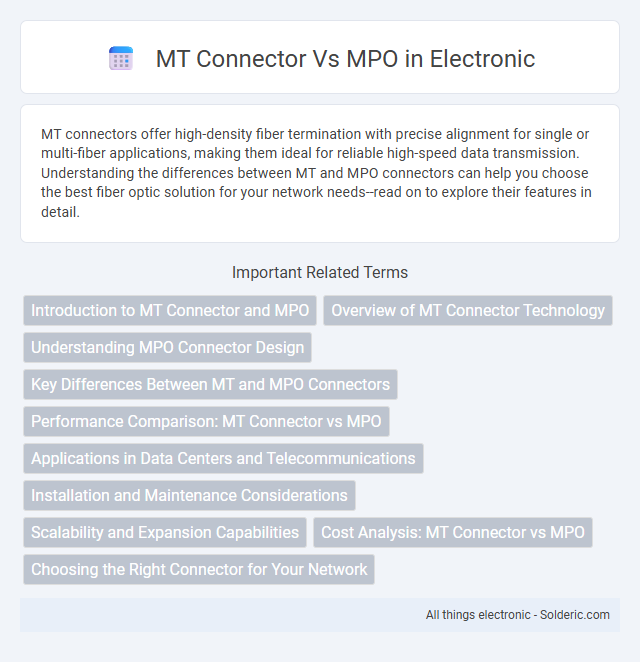MT connectors offer high-density fiber termination with precise alignment for single or multi-fiber applications, making them ideal for reliable high-speed data transmission. Understanding the differences between MT and MPO connectors can help you choose the best fiber optic solution for your network needs--read on to explore their features in detail.
Comparison Table
| Feature | MT Connector | MPO Connector |
|---|---|---|
| Type | Multi-fiber push-on connector | Multi-fiber push-on connector |
| Fiber Count | Typically 12 fibers | Typically 12 or 24 fibers |
| Use Case | High-density fiber connections in telecommunication and data centers | High-density fiber connections in data centers and enterprise networks |
| Standardization | ANSI/TIA-604-5 (FOCIS 5) | ANSI/TIA-604-5 and IEC 61754-7 |
| Insertion Loss | Typically 0.35 dB per connection | Typically 0.35 dB per connection |
| Durability | Up to 500 matings | Up to 500 matings |
| Compatibility | Basis for MPO connector design | Enhanced for easier installation and higher fiber counts |
| Typical Applications | Backbone cabling, optical distribution frames | Data center trunks, high-speed network links |
Introduction to MT Connector and MPO
MT Connectors are fiber optic connectors designed for high-density multifiber applications, featuring a push-pull mechanism that allows easy installation and removal. MPO (Multi-Fiber Push On) connectors are a standardized form of MT connectors, commonly used in data centers for parallel optic applications with configurations supporting 12, 24, or more fibers. Both connectors enable rapid, high-capacity connections, but MPO is widely adopted as the industry standard for seamless high-speed data transmission.
Overview of MT Connector Technology
MT Connector technology features a dual-fiber push-on/pull-off design that enables high-density fiber optic connections with minimal insertion loss and return loss. Its compact structure supports up to 12 fibers in a single connector, making it ideal for high-speed data transmission in telecom and data center environments. You can leverage MT Connectors for efficient, scalable network deployments where MPO connectors are traditionally used.
Understanding MPO Connector Design
MPO connectors feature a compact, multi-fiber array design commonly used in high-density fiber optic networks, enabling efficient 12 to 24 fiber terminations in a single connector. The MT connector, forming the core of MPO technology, provides precise fiber alignment through a metal guide pin system, ensuring minimal insertion loss and high return loss performance. Understanding the MPO connector design highlights its advantage over single-fiber connectors by supporting parallel transmission and high-speed data transfer in modern data center applications.
Key Differences Between MT and MPO Connectors
MT connectors utilize a single-row ferrule designed for ribbon fiber alignment, supporting 12 or 24 fibers, while MPO connectors feature a multi-fiber push-on mechanism accommodating up to 72 fibers in a compact form. MT connectors rely on a precision guiding pin system for fiber alignment, whereas MPO connectors incorporate a push-pull latch for easier mating and un-mating in high-density applications. The key differences lie in their design complexity, fiber capacity, and ease of use, influencing their suitability in high-speed data centers and telecommunication environments.
Performance Comparison: MT Connector vs MPO
MT connectors and MPO connectors both support high-density fiber optic applications but differ significantly in performance metrics such as insertion loss and return loss. MPO connectors typically offer lower insertion loss (around 0.35 dB) and better return loss performance due to their multi-fiber design, supporting up to 12 or 24 fibers per connector for faster data transmission. If optimizing Your network for higher bandwidth and lower attenuation, MPO connectors provide superior performance compared to MT connectors, which are often limited by older single-fiber alignment technology.
Applications in Data Centers and Telecommunications
MT Connectors are widely used in high-density fiber optic systems within data centers, enabling quick and efficient parallel transmission for speeds up to 100 Gbps, ideal for top-of-rack and spine-leaf architectures. MPO connectors, favored in telecommunications, support multi-fiber cables that simplify cable management and enhance scalability in large-scale network deployments, accommodating up to 72 fibers in a single connector. Both connectors facilitate high-speed data transfer and easy installation, but MT Connectors excel in ultra-high-density environments while MPO connectors provide versatility in broader telecom infrastructure applications.
Installation and Maintenance Considerations
MT Connector offers faster installation with its push-pull design and low insertion loss, reducing downtime during deployment. MPO connectors, while requiring precise alignment and cleaning, provide higher port density, making them ideal for complex fiber networks. Your choice should consider ease of maintenance and the specific requirements of your network infrastructure.
Scalability and Expansion Capabilities
MT Connector offers high scalability with its compact design, allowing for easy expansion in high-density fiber optic networks. MPO connectors provide superior scalability through multi-fiber connectivity, supporting up to 72 fibers in a single interface, making them ideal for rapid network growth. Both connectors enhance expansion capabilities, but MPO's multi-fiber design delivers more efficient space utilization in large-scale data centers.
Cost Analysis: MT Connector vs MPO
MT connectors typically present a lower initial cost due to simpler manufacturing and ease of installation, making them cost-effective for smaller-scale deployments. MPO connectors, while more expensive upfront due to their multi-fiber design and complexity, reduce per-fiber costs in high-density environments by supporting 12 or more fibers in a single connector. Total cost of ownership favors MPO in large data centers and enterprise networks where scalability and high-bandwidth demands justify the higher initial investment.
Choosing the Right Connector for Your Network
Selecting the right connector for your network depends on factors like density, performance, and application requirements. MT connectors offer high-density connectivity with multiple fibers in a single interface, ideal for data centers requiring space-saving solutions. MPO connectors provide flexibility and scalability for high-speed data transmission, making them suitable for evolving network environments and future-proofing your infrastructure.
MT Connector vs MPO Infographic

 solderic.com
solderic.com